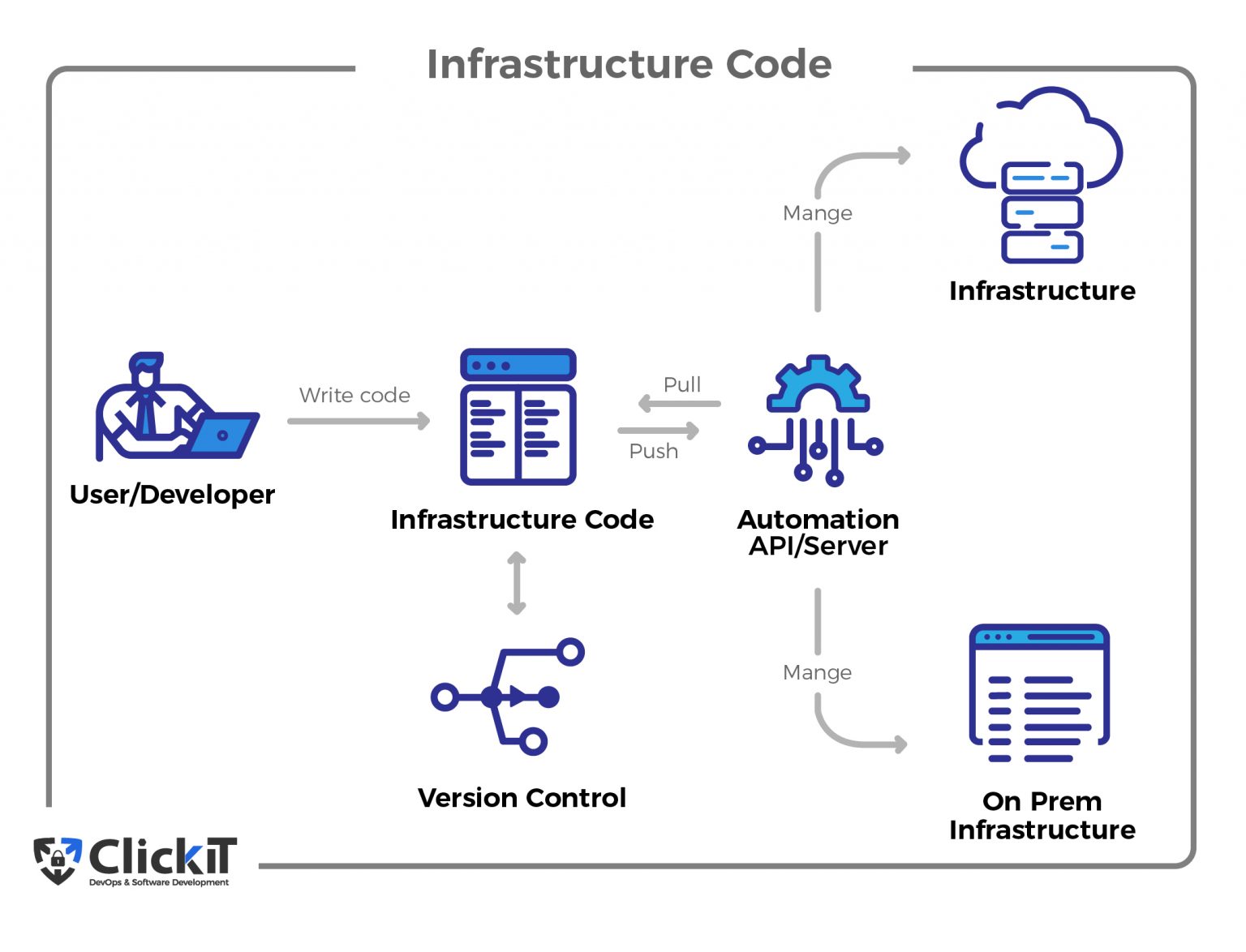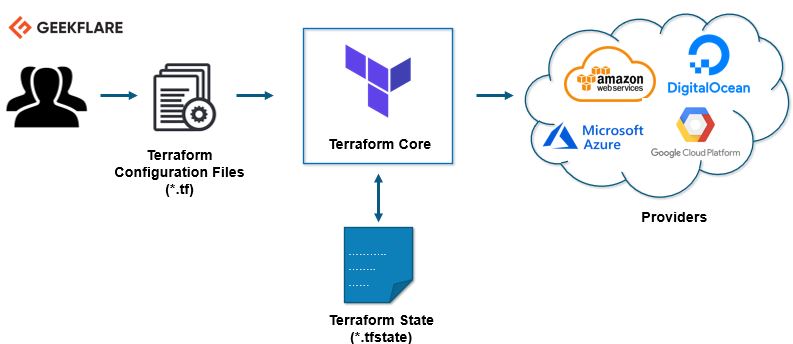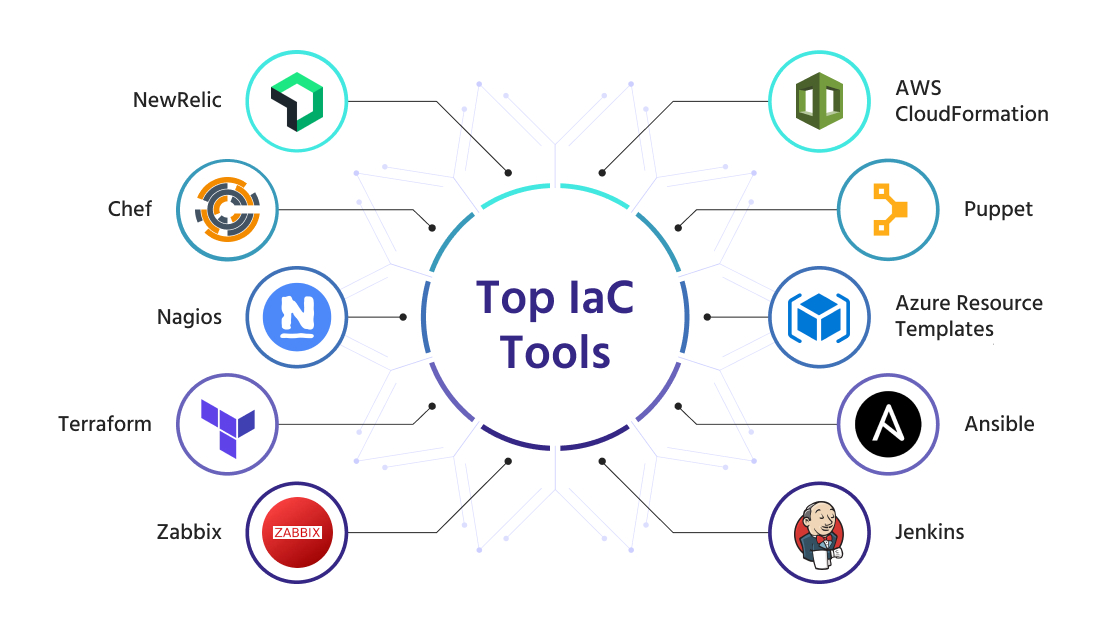What is Infrastructure as Code (IaC)?
Infrastructure as Code (IaC) is a modern approach to managing cloud infrastructure resources, treating them as code. IaC enables version control, collaboration, and automation, making infrastructure management more efficient and less error-prone. By representing infrastructure resources in configuration files, IaC allows developers and operations teams to manage infrastructure using familiar coding and version control tools. This approach significantly reduces manual intervention and ensures consistent, predictable, and scalable infrastructure deployments.
Terraform IaC, in particular, has gained popularity due to its support for multiple cloud providers, declarative language, and robust ecosystem. Terraform IaC simplifies the process of defining, deploying, and managing cloud infrastructure resources, empowering organizations to build and scale their cloud infrastructure more effectively.
The Role of Terraform in IaC
Terraform is a popular open-source Infrastructure as Code (IaC) tool developed by HashiCorp, enabling developers and operations teams to automate infrastructure provisioning and management. Terraform IaC supports multiple cloud providers, including AWS, Azure, Google Cloud, and many others, making it a versatile solution for managing hybrid and multi-cloud environments.
Terraform uses a declarative language, allowing users to define the desired infrastructure state in configuration files. This declarative approach simplifies the process of managing infrastructure resources, as users only need to specify what they want to achieve, rather than focusing on the implementation details. Terraform automatically calculates the necessary steps to reach the desired state and applies the required changes, ensuring that the actual infrastructure state matches the defined configuration.
Some key benefits of using Terraform IaC include:
- Infrastructure as code: By representing infrastructure resources in configuration files, Terraform enables version control, collaboration, and automation, making infrastructure management more efficient and less error-prone.
- Idempotent resource management: Terraform ensures that infrastructure resources are consistently configured, regardless of the number of times the configuration is applied. This idempotent behavior simplifies infrastructure management and reduces the risk of inconsistencies.
- Modular infrastructure design: Terraform supports modular infrastructure design, allowing users to break down complex infrastructure configurations into smaller, reusable modules. This approach promotes code reuse, improves maintainability, and simplifies collaboration.
- Resource dependencies management: Terraform automatically manages resource dependencies, ensuring that resources are created, updated, or deleted in the correct order. This feature reduces the risk of orphaned resources and ensures that infrastructure remains consistent and functional.
- Community-driven ecosystem: Terraform has a large and active community, contributing to a rich ecosystem of modules, providers, and tools. This community support simplifies the process of managing infrastructure resources and ensures that Terraform remains up-to-date with the latest cloud services and features.
Key Terraform Concepts and Components
Terraform IaC relies on several essential concepts and components to create and manage infrastructure resources. Understanding these concepts is crucial for effectively using Terraform to manage your infrastructure:
Providers
Terraform providers are plugins that enable Terraform to interact with various cloud services, APIs, and infrastructure platforms. Each provider extends Terraform’s functionality, allowing users to manage resources from multiple cloud providers, such as AWS, Azure, Google Cloud, and many others. Providers also offer resources, data sources, and arguments specific to their respective cloud services.
Resources
Resources are the core building blocks of Terraform IaC. They represent infrastructure components, such as virtual machines, databases, load balancers, and security groups. Users define resources in configuration files, specifying their desired properties and configurations. Terraform automatically translates resource definitions into API calls to create, update, or delete the corresponding infrastructure resources.
Variables
Variables allow users to parameterize Terraform configurations, making them more flexible and reusable. Variables can be defined in configuration files or passed as command-line arguments when applying the configuration. By using variables, users can easily customize infrastructure configurations for different environments, such as development, staging, and production.
Outputs
Outputs are values that Terraform returns after applying a configuration. They can be used to expose essential information about the managed infrastructure, such as public IP addresses, resource IDs, or connection strings. Outputs can be used within other Terraform configurations, passed to other tools, or simply displayed for reference.
State
Terraform state is a local file (or remote backend) that stores the current state of managed infrastructure resources. The state file enables Terraform to track the actual state of infrastructure resources and determine the necessary actions to apply changes, ensuring that the actual infrastructure state matches the desired configuration. Properly managing the state file is crucial for maintaining the consistency and reliability of Terraform IaC.
By understanding these key concepts and components, users can effectively create, manage, and maintain infrastructure resources using Terraform IaC.
How to Implement Terraform IaC: A Step-by-Step Guide
This section provides a beginner-friendly tutorial on implementing Terraform IaC, covering installation, writing configuration files, applying changes, and managing state. We will use a real-world example to illustrate the process.
Step 1: Install Terraform
Download and install the appropriate Terraform version for your operating system from the official HashiCorp downloads page: https://www.terraform.io/downloads.html. After installation, verify the installation by running terraform --version in your terminal or command prompt.
Step 2: Write a Terraform Configuration File
Create a new file named main.tf and define the desired infrastructure resources using the HashiCorp Configuration Language (HCL). For example, to create an AWS EC2 instance, include the following content in main.tf:
provider "aws" { region = "us-west-2" } resource "aws_instance" "example" {
ami = "ami-0c94855ba95c574c8"
instance_type = "t2.micro"
tags = {
Name = "example-instance"
}
}Replace the ami value with the appropriate Amazon Machine Image (AMI) ID for your desired instance type and region.
Step 3: Initialize Terraform
In your terminal or command prompt, navigate to the directory containing the main.tf file and run terraform init. This command initializes the backend, downloads the required provider plugins, and creates a terraform.tfstate file to manage the infrastructure state.
Step 4: Apply the Configuration
Run terraform apply to create the specified AWS EC2 instance. Terraform will prompt you to confirm the actions before applying the changes. Once confirmed, Terraform will create the instance and update the state file accordingly.
Step 5: Manage the Infrastructure State
Terraform state management is crucial for maintaining the consistency and reliability of your infrastructure. Use terraform show to display the current state, terraform refresh to update the state with real-world changes, and terraform destroy to destroy the managed resources.
By following this step-by-step guide, you can successfully implement Terraform IaC and manage your infrastructure resources effectively.
Best Practices for Terraform IaC
Adopting best practices in Terraform IaC can significantly improve efficiency, maintainability, and security. Here are some recommended practices to follow:
Modularization
Break down large Terraform configurations into smaller, reusable modules. Modularization promotes code reuse, simplifies collaboration, and makes configurations more manageable. Organize modules by functionality, such as networking, security, or compute resources, and version-control them for tracking changes and dependencies.
Version Control
Use version control systems, such as Git, to manage Terraform configurations. Version control enables tracking changes, collaboration, and rollbacks to previous configurations. Commit changes frequently, write clear commit messages, and create meaningful branches for different environments or features.
Testing
Implement testing strategies to ensure the stability and reliability of Terraform configurations. Use tools like Terratest, Kitchen Terraform, or InSpec to write automated tests that verify resource properties, dependencies, and behavior. Incorporate testing into your CI/CD pipelines to catch issues early and maintain high-quality configurations.
Collaboration
Promote collaboration among team members by using shared workspaces, such as Terraform Cloud or Atlantis. Shared workspaces enable real-time collaboration, automated workflows, and version control integration. Additionally, establish clear communication channels, documentation, and code review processes to ensure that changes are well-understood and approved by the team.
Security
Implement security best practices, such as using least privilege principles, securing sensitive data, and following security guidelines for cloud resources. Encrypt sensitive data, such as access keys and passwords, using tools like Vault or Sops. Regularly review and update security configurations to address new threats and vulnerabilities.
Documentation
Document Terraform configurations, modules, and workflows to ensure that team members and stakeholders understand the infrastructure resources and their dependencies. Use clear, concise descriptions, and include examples and tutorials to help users get started. Maintain up-to-date documentation and make it easily accessible to the team.
By following these best practices, you can ensure that your Terraform IaC implementation is efficient, maintainable, and secure, ultimately leading to better infrastructure management and more successful projects.
Comparing Terraform with Other IaC Tools
This section compares Terraform with other Infrastructure as Code (IaC) tools, such as AWS CloudFormation, Azure Resource Manager, Google Cloud Deployment Manager, and Ansible. We will discuss the strengths and weaknesses of each tool in various scenarios.
Terraform vs. AWS CloudFormation
AWS CloudFormation is a native IaC tool for AWS, while Terraform supports multiple cloud providers, including AWS. Terraform offers a more flexible, provider-agnostic approach, while CloudFormation is deeply integrated with AWS services. However, Terraform’s declarative language and modularization capabilities make it more user-friendly and maintainable than CloudFormation.
Terraform vs. Azure Resource Manager (ARM)
Azure Resource Manager (ARM) is a native IaC tool for Azure, while Terraform supports multiple cloud providers, including Azure. Similar to the comparison with AWS CloudFormation, Terraform provides a more flexible, provider-agnostic approach, while ARM is deeply integrated with Azure services. Again, Terraform’s declarative language and modularization capabilities make it more user-friendly and maintainable than ARM.
Terraform vs. Google Cloud Deployment Manager
Google Cloud Deployment Manager is a native IaC tool for Google Cloud, while Terraform supports multiple cloud providers, including Google Cloud. While Deployment Manager offers deep integration with Google Cloud services, Terraform’s flexibility, declarative language, and modularization capabilities make it a more user-friendly and maintainable choice for managing infrastructure resources across multiple cloud providers.
Terraform vs. Ansible
Ansible is an open-source automation tool that supports IaC, configuration management, and application deployment. While Ansible focuses on automating tasks and workflows, Terraform specializes in infrastructure provisioning and management. Combining Terraform and Ansible can provide a powerful, full-stack automation solution, where Terraform manages infrastructure resources and Ansible handles configuration management and application deployment.
In summary, Terraform’s flexibility, support for multiple cloud providers, declarative language, and modularization capabilities make it a strong choice for managing infrastructure resources across various scenarios. However, native IaC tools like AWS CloudFormation, Azure Resource Manager, and Google Cloud Deployment Manager offer deep integration with their respective cloud platforms, which can be beneficial in specific use cases.
Terraform IaC Success Stories and Case Studies
This section shares real-world success stories and case studies of Terraform IaC, highlighting the challenges, solutions, and benefits experienced by organizations across various industries and cloud providers.
Case Study 1: Financial Services Company
A financial services company used Terraform IaC to manage their multi-cloud infrastructure, including AWS, Azure, and Google Cloud. By implementing Terraform, the company achieved a 50% reduction in infrastructure provisioning time, improved collaboration among teams, and increased security by using least privilege principles and encryption for sensitive data.
Case Study 2: E-commerce Platform
An e-commerce platform leveraged Terraform IaC to automate their infrastructure management and reduce operational overhead. By using modularization, version control, and testing best practices, the platform improved efficiency, maintainability, and security. As a result, the platform experienced a 30% decrease in deployment time and a 20% reduction in infrastructure costs.
Case Study 3: Healthcare Provider
A healthcare provider adopted Terraform IaC to manage their complex, hybrid infrastructure, including on-premises and cloud resources. By implementing Terraform, the provider improved infrastructure consistency, reduced human errors, and accelerated disaster recovery processes. The provider also benefited from better collaboration among teams, faster onboarding for new team members, and a 40% decrease in infrastructure management time.
Case Study 4: Software Development Firm
A software development firm used Terraform IaC to manage their container orchestration infrastructure with Kubernetes. By integrating Terraform with their CI/CD pipelines, the firm automated infrastructure provisioning, scaling, and updates. The firm experienced a 60% reduction in infrastructure management time, improved security, and better resource utilization.
These case studies demonstrate the significant benefits and real-world applications of Terraform IaC in various industries and cloud provider environments. By adopting Terraform IaC, organizations can improve efficiency, maintainability, and security while reducing infrastructure management time and costs.
Future Trends and Developments in Terraform IaC
This section explores future trends and developments in Terraform IaC, such as integration with container orchestration tools, support for emerging cloud services, and improvements in collaboration and version control.
Integration with Container Orchestration Tools
Terraform IaC is increasingly being used in conjunction with container orchestration tools like Kubernetes, Docker Swarm, and Apache Mesos. By integrating Terraform with these tools, organizations can manage their container infrastructure alongside their traditional cloud resources, ensuring consistent and efficient infrastructure management.
Support for Emerging Cloud Services
Terraform IaC is continuously expanding its support for emerging cloud services, including serverless computing, IoT platforms, and machine learning services. By staying up-to-date with these new services, Terraform enables organizations to leverage the latest cloud technologies while maintaining a consistent and automated approach to infrastructure management.
Improvements in Collaboration and Version Control
Terraform IaC is expected to see improvements in collaboration and version control features, making it easier for teams to work together on infrastructure configurations. These improvements may include better integration with popular version control systems, enhanced collaboration tools, and more robust access control features.
Adoption of GitOps Practices
GitOps is an emerging practice that applies Git workflows to operations, enabling teams to manage infrastructure and applications using the same version control tools and practices. As Terraform IaC continues to evolve, it is expected to see more organizations adopting GitOps practices, further streamlining infrastructure management and collaboration.
Expanded Multi-Cloud and Hybrid Cloud Support
Terraform IaC is expected to expand its support for multi-cloud and hybrid cloud environments, enabling organizations to manage their infrastructure across multiple cloud providers and on-premises resources more effectively. This expanded support will help organizations leverage the unique strengths of each cloud provider while maintaining a consistent infrastructure management approach.
By staying aware of these future trends and developments, organizations can ensure they are making the most of their Terraform IaC implementations and staying ahead in the ever-evolving world of cloud infrastructure management.






